HONDA BF20D User Manual
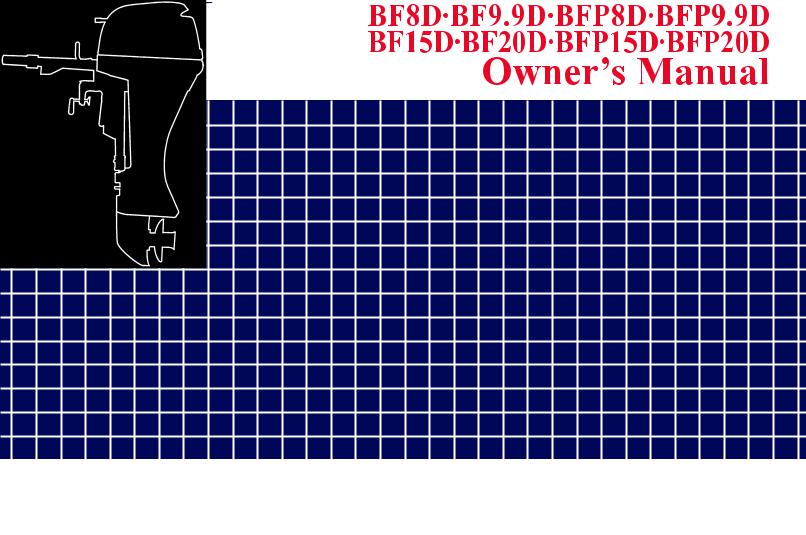

The engine exhaust from this product contains chemicals known to the State of California to cause cancer, birth defects, or other reproductive harm.
Keep this owner’s manual handy, so you can refer to it at any time. This owner’s manual is considered a permanent part of the outboard motor and should remain with the outboard motor if resold.
 2006 Honda Motor Co., Ltd. All Rights Reserved
2006 Honda Motor Co., Ltd. All Rights Reserved
The information and specifications included in this publication were in effect at the time of approval for printing. Honda Motor Co., Ltd. reserves the right, however, to discontinue or change specifications or design at any time without notice and without incurring any obligation whatever. No part of this publication may be reproduced without written permission.
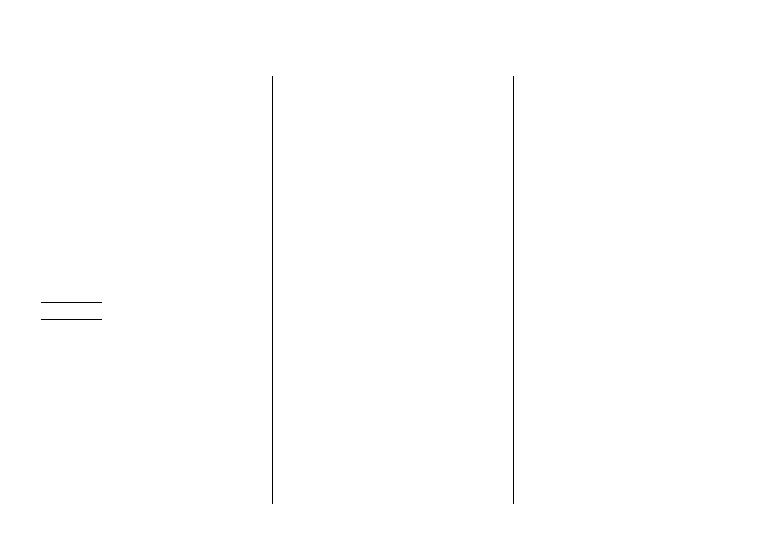
Congratulations on your selection of a Honda outboard motor. We are certain you will be pleased with your purchase of one of the finest outboard motors on the market.
We want to help you get the best results from your new outboard motor and to operate it safely. This manual contains information on how to do that; please read it carefully.
As you read this manual you will find information preceded by a





 symbol. That information is intended to help you avoid damage to your outboard motor, other property, or the environment.
symbol. That information is intended to help you avoid damage to your outboard motor, other property, or the environment.
INTRODUCTION
We suggest you read the warranty policy to fully understand its coverage and your responsibilities of ownership.
When your outboard motor needs scheduled maintenance, keep in mind that your Honda Marine dealer is specially trained in servicing Honda outboard motors. Your Honda Marine dealer is dedicated to your satisfaction and will be pleased to answer your questions and concerns.
Best Wishes,
Honda Motor Co., Ltd.
1
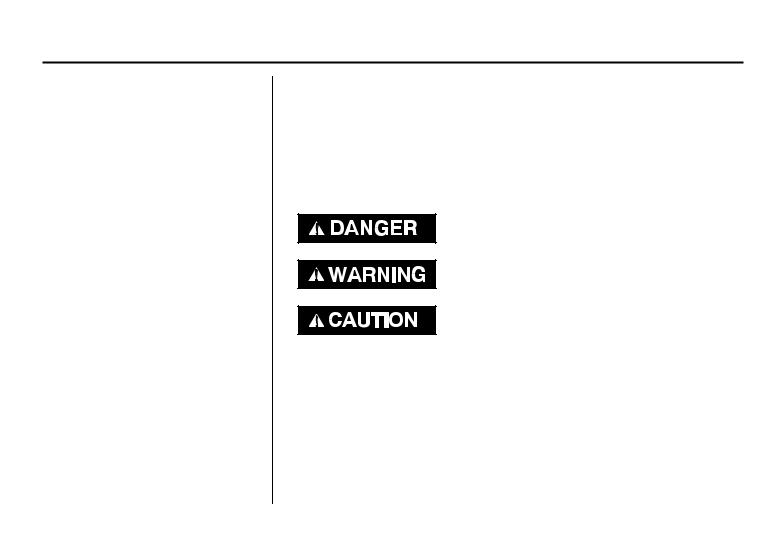
INTRODUCTION
A FEW WORDS ABOUT SAFETY
Your safety and the safety of others are very important. And using this outboard motor safely is an important responsibility.
To help you make informed decisions about safety, we have provided operating procedures and other information on labels and in this manual. This information alerts you to potential hazards that could hurt you or others.
Of course, it is not practical or possible to warn you about all the hazards associated with operating or maintaining an outboard motor. You must use your own good judgment.
You will find important safety information in a variety of forms, including:
 Safety Labels on the outboard motor.
Safety Labels on the outboard motor.
 Safety Messages preceded by a safety alert symbol
Safety Messages preceded by a safety alert symbol  and one of three signal words, DANGER, WARNING, or CAUTION.
and one of three signal words, DANGER, WARNING, or CAUTION.
These signal words mean:
You WILL be KILLED or SERIOUSLY
HURT if you don’t follow instructions.
You CAN be KILLED or SERIOUSLY
HURT if you don’t follow instructions.
You CAN be HURT if you don’t follow instructions.
 Safety Headings such as IMPORTANT SAFETY INFORMATION.
Safety Headings such as IMPORTANT SAFETY INFORMATION.
 Safety Section such as OUTBOARD MOTOR SAFETY.
Safety Section such as OUTBOARD MOTOR SAFETY.
 Instructions how to use this outboard motor correctly and safely.
Instructions how to use this outboard motor correctly and safely.
This entire book is filled with important safety information please read it carefully.
2

OUTBOARD MOTOR SAFETY................................... |
. 7 |
IMPORTANT SAFETY INFORMATION................ |
. 7 |
SAFETY LABEL LOCATIONS................................ |
. 9 |
CONTROLS AND FEATURES ................................... |
10 |
CONTROL AND FEATURE |
|
IDENTIFICATION CODES ................................. |
10 |
COMPONENT AND CONTROL LOCATIONS ..... |
14 |
CONTROLS............................................................... |
19 |
H Type (tiller handle) |
|
Engine Stop Switch and Switch Clip..................... |
19 |
Choke Knob (H type manual choke) ..................... |
19 |
Throttle Grip........................................................... |
20 |
Throttle Friction Adjuster ...................................... |
20 |
Gearshift Lever ...................................................... |
20 |
Starter Grip............................................................. |
21 |
Electric Starter Button |
|
(types equipped with electric starter) ................. |
21 |
Steering Friction Lever .......................................... |
21 |
Power Tilt Switch (T type)..................................... |
22 |
R Type (remote control) |
|
Ignition Switch ....................................................... |
23 |
Emergency Stop Switch and Switch Clip.............. |
23 |
Fast Idle Lever........................................................ |
24 |
Gearshift/Throttle Control Lever........................... |
25 |
Power Tilt Switch (T type)..................................... |
26 |
Manual Relief Valve (T type)................................ |
26 |
CONTENTS |
|
Tilt Lock Lever (T type) ........................................ |
27 |
Common Controls |
|
Engine Cover Latch ............................................... |
27 |
Transom Angle Adjusting Rod .............................. |
27 |
Tilt Lever (manual tilt type)................................... |
28 |
INSTRUMENTS........................................................ |
29 |
Fuel Gauge ............................................................. |
29 |
Tachometer [optional equipment (R type)] ........... |
29 |
INDICATORS............................................................ |
30 |
Oil Pressure Indicator (R type) (H type)................ |
30 |
Overheat Indicator.................................................. |
30 |
R type ................................................................. |
30 |
H type ................................................................. |
31 |
Cooling System Indicator ...................................... |
31 |
OTHER FEATURES ................................................. |
32 |
Overrev Limiter...................................................... |
32 |
Automatic Choke |
|
(types equipped with electric starter) ................. |
32 |
Anodes.................................................................... |
32 |
Portable Fuel Tank ................................................. |
33 |
Fuel Filler Cap Vent Knob..................................... |
33 |
Fuel Priming Bulb.................................................. |
33 |
3
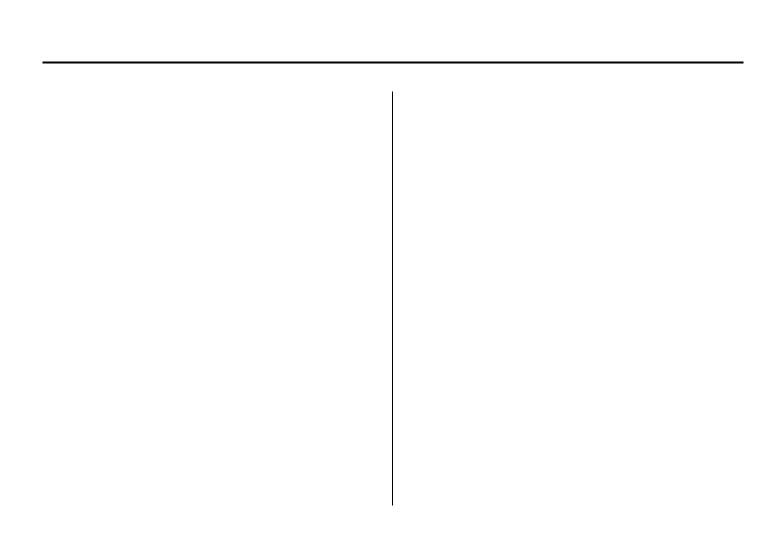
CONTENTS
INSTALLATION........................................................... |
34 |
POWER REQUIREMENTS...................................... |
34 |
BOAT TRANSOM REQUIREMENTS.................... |
34 |
INSTALLATION POSITION ................................... |
34 |
ATTACHMENT ........................................................ |
35 |
TRANSOM ANGLE ADJUSTMENT ...................... |
36 |
BATTERY CONNECTIONS.................................... |
37 |
BEFORE OPERATION................................................. |
40 |
ARE YOU READY TO GET UNDER WAY ...... |
40 |
IS YOUR OUTBOARD MOTOR |
|
READY TO GO ................................................. |
40 |
OPERATION ................................................................. |
42 |
SAFE OPERATING PRECAUTIONS ..................... |
42 |
BREAK-IN PROCEDURE........................................ |
42 |
TRANSOM ANGLE ADJUSTMENT ...................... |
43 |
PORTABLE FUEL TANK........................................ |
45 |
FUEL HOSE CONNECTIONS................................. |
45 |
FUEL PRIMING........................................................ |
46 |
STARTING THE ENGINE ....................................... |
46 |
H Type (tiller handle)............................................. |
46 |
R Type (remote control)......................................... |
49 |
EMERGENCY STARTING...................................... |
51 |
STOPPING THE ENGINE........................................ |
54 |
Emergency Engine Stopping ................................. |
54 |
Normal Engine Stopping........................................ |
54 |
GEARSHIFT AND |
|
THROTTLE OPERATION ............................... |
56 |
H Type (tiller handle)............................................. |
56 |
R Type (remote control)......................................... |
57 |
STEERING ................................................................ |
58 |
H Type (tiller handle)............................................. |
58 |
R Type (remote control)......................................... |
58 |
CRUISING ................................................................. |
59 |
SHALLOW WATER OPERATION......................... |
61 |
MOORING, BEACHING, LAUNCHING................ |
63 |
4

CONTENTS
SERVICING YOUR OUTBOARD MOTOR ............... |
65 |
THE IMPORTANCE OF MAINTENANCE ............ |
65 |
MAINTENANCE SAFETY ...................................... |
66 |
TOOL KIT AND EMERGENCY STARTER |
|
ROPE...................................................................... |
67 |
MAINTENANCE SCHEDULE ................................ |
68 |
MANUAL RELIEF VALVE (T type)....................... |
70 |
ENGINE COVER REMOVAL AND |
|
INSTALLATION................................................... |
70 |
Engine Oil Level Check ............................................. |
71 |
Engine Oil Change ..................................................... |
72 |
Oil Filter Change........................................................ |
73 |
Engine Oil Recommendations ................................... |
74 |
Gear Case Oil Level Check........................................ |
74 |
Gear Case Oil Change................................................ |
75 |
Lubrication Points ...................................................... |
77 |
Spark Plug Service ..................................................... |
78 |
REFUELING.............................................................. |
79 |
FUEL RECOMMENDATIONS................................ |
80 |
Fuel Filter Inspection and Replacement .................... |
81 |
Portable Fuel Tank and Tank Filter Cleaning............ |
83 |
Recoil Starter Rope Inspection .................................. |
84 |
Anode Replacement ................................................... |
84 |
Choke Knob Friction (manual choke type) ............... |
85 |
Propeller Replacement ............................................... |
85 |
STORAGE .................................................................... |
. 87 |
STORAGE PREPARATION ................................... |
. 87 |
Cleaning and Flushing .......................................... |
. 87 |
Fuel........................................................................ |
. 88 |
Engine Oil ............................................................. |
. 91 |
STORAGE PRECAUTIONS ................................... |
. 91 |
REMOVAL FROM STORAGE............................... |
. 92 |
TRANSPORTING ........................................................ |
. 93 |
WITH OUTBOARD MOTOR INSTALLED |
|
ON BOAT ............................................................. |
. 93 |
WITH OUTBOARD MOTOR REMOVED |
|
FROM BOAT ....................................................... |
. 93 |
TAKING CARE OF UNEXPECTED PROBLEMS ................ |
94 |
ELECTRIC STARTER WILL NOT OPERATE ..... |
. 94 |
ENGINE WILL NOT START.................................. |
. 95 |
HARD STARTING OR STALLS AFTER |
|
STARTING ........................................................... |
. 97 |
ENGINE OVERHEATS........................................... |
. 98 |
BATTERY WILL NOT CHARGE AND |
|
ELECTRIC STARTER WILL NOT OPERATE.. |
99 |
Fuse Replacement ................................................. |
. 99 |
OIL PRESSURE INDICATOR GOES OFF AND |
|
ENGINE SPEED IS LIMITED ........................... |
100 |
OVERHEAT AND ENGINE SPEED IS LIMITED .......... |
101 |
SUBMERGED MOTOR ......................................... |
103 |
5
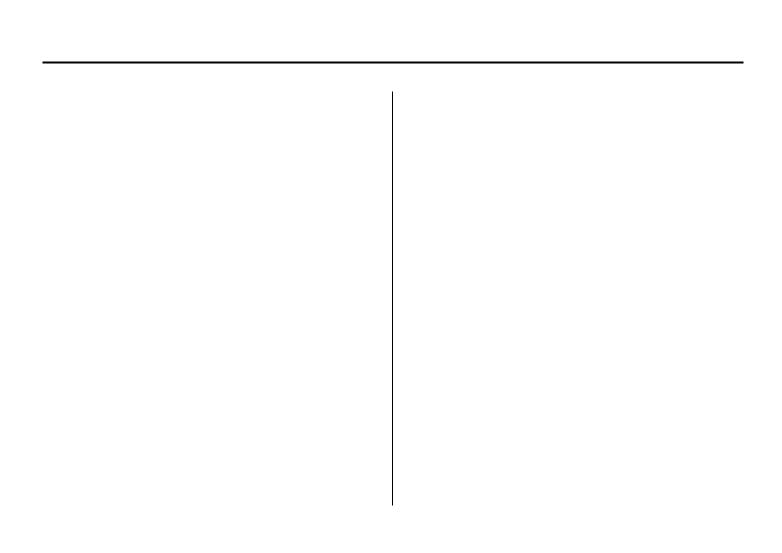
CONTENTS
TECHNICAL AND CONSUMER |
|
|
INFORMATION................................................. |
. |
105 |
TECHNICAL INFORMATION............................. |
. |
105 |
Serial Number locations...................................... |
. |
105 |
Carburetor Modification for High Altitude |
|
|
Operation......................................................... |
. |
106 |
Emission Control System Information ................ |
107 |
|
Star Label ............................................................ |
. |
109 |
Specifications...................................................... |
. |
111 |
CONSUMER INFORMATION ............................. |
. |
119 |
Honda Publications ............................................. |
. |
119 |
Customer Service Information............................ |
. |
119 |
Distributor’s Limited Warranty .......................... |
. |
122 |
Emission Control System Warranty .................... |
126 |
|
INDEX......................................................................... |
. |
130 |
WIRING DIAGRAMS .......................... |
Inside back cover |
|
This Owner’s Manual uses the following Type names when describing an operation unique to a particular Type:
Tiller handle type: |
H type |
Remote control type: |
R type |
Power tilt type: |
T type |
Check the type of your outboard motor and read this Owner’s Manual thoroughly before operation.
Text with no Type indication refers to information/ procedures common to all Types.
6

IMPORTANT SAFETY INFORMATION
The Honda BF8D/BFP8D/BF9.9D/ BFP9.9D/BF15D/BFP15D/BF20D and BFP20D outboard motors are designed for use with boats that have a suitable manufacturer’s power recommendation. Other uses can result in injury to the operator or damage to the outboard motor and other property.
Most accidents can be prevented if you follow all instructions in this manual and on the outboard motor. The most common hazards are discussed in this chapter, along with the best way to protect yourself and others.
OUTBOARD MOTOR SAFETY
Operator Responsibility
 It is the operator’s responsibility to provide the necessary safeguards to protect people and property. Know how to stop the engine quickly in case of emergency. Understand the use of all controls.
It is the operator’s responsibility to provide the necessary safeguards to protect people and property. Know how to stop the engine quickly in case of emergency. Understand the use of all controls.
 Stop the engine immediately if anyone falls overboard, and do not run the engine while the boat is near anyone in the water.
Stop the engine immediately if anyone falls overboard, and do not run the engine while the boat is near anyone in the water.
 Always stop the engine if you must leave the controls for any reason.
Always stop the engine if you must leave the controls for any reason.
 Attach the emergency stop switch lanyard securely to the operator.
Attach the emergency stop switch lanyard securely to the operator.
 Always wear a PFD (Personal Flotation Device) while on the boat.
Always wear a PFD (Personal Flotation Device) while on the boat.
 Familiarize yourself with all laws and regulations relating to boating and the use of outboard motors.
Familiarize yourself with all laws and regulations relating to boating and the use of outboard motors.
 Be sure that anyone who operates the outboard motor receives proper instruction.
Be sure that anyone who operates the outboard motor receives proper instruction.
 Be sure the outboard motor is properly mounted on the boat.
Be sure the outboard motor is properly mounted on the boat.
 Do not remove the engine cover while the engine is running.
Do not remove the engine cover while the engine is running.
7
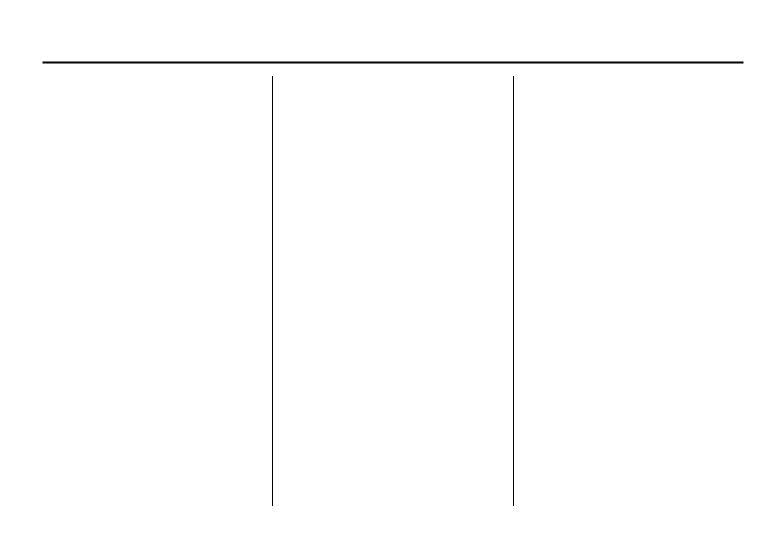
OUTBOARD MOTOR SAFETY
Refuel With Care
 Gasoline is extremely flammable, and gasoline vapor can explode. Refuel outdoors, in a wellventilated area, with the engine stopped. Never smoke near gasoline, and keep other flames and sparks away.
Gasoline is extremely flammable, and gasoline vapor can explode. Refuel outdoors, in a wellventilated area, with the engine stopped. Never smoke near gasoline, and keep other flames and sparks away.
 Remove any portable fuel tank from the boat for refueling. Keep the portable fuel tank away from the battery or other potential spark sources.
Remove any portable fuel tank from the boat for refueling. Keep the portable fuel tank away from the battery or other potential spark sources.
 Refuel carefully to avoid spilling fuel. Avoid overfilling the fuel tank.
Refuel carefully to avoid spilling fuel. Avoid overfilling the fuel tank.
 After refueling, tighten the filler cap securely. If any fuel is spilled, make sure the area is dry before starting the engine.
After refueling, tighten the filler cap securely. If any fuel is spilled, make sure the area is dry before starting the engine.
Carbon Monoxide Hazard
Exhaust gas contains poisonous carbon monoxide. Avoid inhalation of exhaust gas. Never run the engine in a closed garage or confined area.
8

OUTBOARD MOTOR SAFETY
SAFETY LABEL LOCATIONS
The labels shown here contain important safety information. Please read them carefully. These labels are considered permanent parts of your outboard motor. If a label comes off or becomes hard to read, contact an authorized Honda Marine dealer for a replacement.
9

CONTROLS AND FEATURES
CONTROL AND FEATURE IDENTIFICATION CODES
Model |
|
BF8D |
|
|
BFP8D |
|
|
Type |
SHA |
LHA LHSA LHA XHSA LHTA LRTA |
|||||
Shaft Length |
S |
L |
L |
L |
X |
L |
L |
Tiller Handle |
H |
H |
H |
H |
H |
H |
|
Remote Control |
|
|
|
|
|
|
|
Electric Starter |
|
|
S |
|
S |
S |
S |
Power Tilt |
|
|
|
|
|
T |
T |
Power Thrust Propeller |
|
|
|
P |
P |
P |
P |
Battery Charging DC |
|
|
|
|
|
|
|
Receptacle |
|
|
|
|
|
|
|
Tachometer |
|
|
|
|
|
|
|
Refer to this chart for an explanation of the Type Codes used in this manual to identify control and feature applications.
BF8D/BFP8D are provided with the |
Tilt system |
|
|
|
(Example) |
|
|
|
|
||||||
following types according to the shaft |
T : Power Tilt (with hydraulic assist |
|
L |
|
H |
S |
A |
||||||||
length, control system, tilt system, and start |
function) |
|
|
|
|
|
|
|
|
|
|
|
|
|
|
system. |
|
|
|
|
|
|
|
|
|
|
|
|
|
|
Destination |
|
|
|
|
|
|
|
|
|
|
|
|
|
|
||
Shaft Length |
|
|
|
|
|
|
|
|
|
|
|
|
|
|
A=United States |
|
|
|
|
|
|
|
|
|
|
|
|
|
|
S=Electric Starter |
|
|
|
|
|
|
|
|
|
|
|
|
|
|
|
||
S: Short Shaft |
|
|
|
|
|
|
|
|
|
|
|
|
|
|
T=Power Tilt |
L: Long Shaft |
|
|
|
|
|
|
|
|
|
|
|
|
|
|
None=Manual Tilt |
X: Extra Long Shaft |
|
|
|
|
|
|
|
|
|
|
|
|
|
|
R=Remote Control |
|
|
|
|
|
|
|
|
|
|
|
|
|
|
||
Control System |
|
|
|
|
|
|
|
|
|
|
|
|
|
|
H=Tiller Handle |
H: Tiller Handle Control |
|
|
|
|
|
|
|
|
|
|
|
|
|
|
S=Short Shaft |
|
|
|
|
|
|
|
|
|
|
|
|
|
|
||
R: Remote Control |
|
|
|
|
|
|
|
|
|
|
|
|
|
|
L=Long Shaft |
|
: Optional Equipment |
|
|
|
|
|
|
|
|
|
|
|
|
|
X=Extra Long Shaft |
|
|
|
|
|
|
|
|
|
|
|
|
|
|
|
|
|
: Standard Equipment |
|
|
|
|
|
|
|
|
|
|
|
|
|
|
|
|
|
|
|
|
|
|
|
|
|
|
|
|
|
|
10
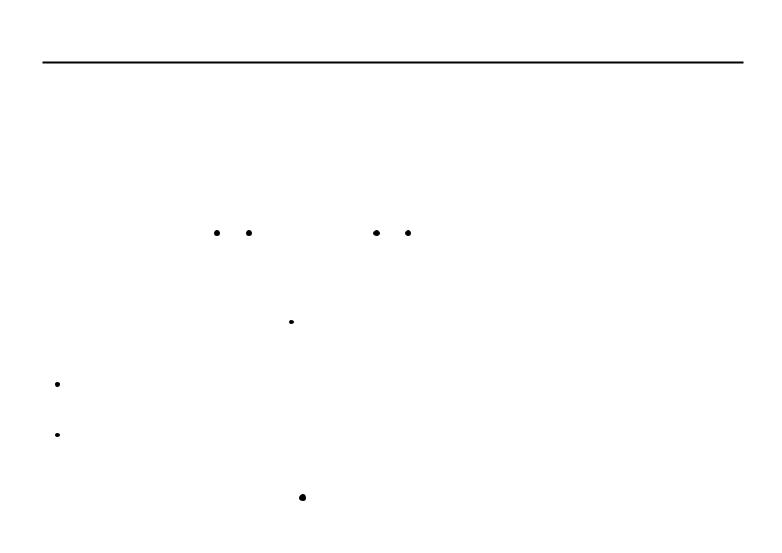
CONTROLS AND FEATURES
Model |
|
|
BF9.9D |
|
|
|
|
|
BFP9.9D |
|
|
|
||
Type |
SHA |
LHA |
SHSA |
LHSA |
LRA |
LHA |
XHA |
XHSA |
LRA |
LHTA |
XHTA |
LRTA |
XRTA |
|
|
|
|
|
|
|
|
|
|
|
|
|
|
|
|
Shaft Length |
S |
L |
S |
|
L |
L |
L |
X |
X |
L |
L |
X |
L |
X |
Tiller Handle |
H |
H |
H |
|
H |
|
H |
H |
H |
|
H |
H |
|
|
Remote Control |
|
|
|
|
|
|
|
|
|
|
|
|
|
|
Electric Starter |
|
|
S |
|
S |
S |
|
|
S |
S |
S |
S |
S |
S |
Power Tilt |
|
|
|
|
|
|
|
|
|
|
T |
T |
T |
T |
Power Thrust Propeller |
|
|
|
|
|
|
P |
P |
P |
P |
P |
P |
P |
P |
Battery Charging DC |
|
|
|
|
|
|
|
|
|
|
|
|
|
|
Receptacle |
|
|
|
|
|
|
|
|
|
|
|
|
|
|
Tachometer |
|
|
|
|
|
|
|
|
|
|
|
|
|
|
Refer to this chart for an explanation of the Type Codes used in this manual to identify control and feature applications.
BF9.9D/BFP9.9D are provided with the |
Tilt system |
|
|
|
(Example) |
|
|
|
|
||||||
following types according to the shaft |
T : Power Tilt (with hydraulic assist |
|
L |
|
H |
S |
A |
||||||||
length, control system, tilt system, and start |
function) |
|
|
|
|
|
|
|
|
|
|
|
|
|
|
system. |
|
|
|
|
|
|
|
|
|
|
|
|
|
|
Destination |
|
|
|
|
|
|
|
|
|
|
|
|
|
|
||
Shaft Length |
|
|
|
|
|
|
|
|
|
|
|
|
|
|
A=United States |
|
|
|
|
|
|
|
|
|
|
|
|
|
|
S=Electric Starter |
|
|
|
|
|
|
|
|
|
|
|
|
|
|
|
||
S: Short Shaft |
|
|
|
|
|
|
|
|
|
|
|
|
|
|
T=Power Tilt |
L: Long Shaft |
|
|
|
|
|
|
|
|
|
|
|
|
|
|
None=Manual Tilt |
X: Extra Long Shaft |
|
|
|
|
|
|
|
|
|
|
|
|
|
|
R=Remote Control |
|
|
|
|
|
|
|
|
|
|
|
|
|
|
||
Control System |
|
|
|
|
|
|
|
|
|
|
|
|
|
|
H=Tiller Handle |
H: Tiller Handle Control |
|
|
|
|
|
|
|
|
|
|
|
|
|
|
S=Short Shaft |
|
|
|
|
|
|
|
|
|
|
|
|
|
|
||
R: Remote Control |
|
|
|
|
|
|
|
|
|
|
|
|
|
|
L=Long Shaft |
|
: Optional Equipment |
|
|
|
|
|
|
|
|
|
|
|
|
|
X=Extra Long Shaft |
|
|
|
|
|
|
|
|
|
|
|
|
|
|
|
|
|
: Standard Equipment |
|
|
|
|
|
|
|
|
|
|
|
|
|
|
|
|
|
|
|
|
|
|
|
|
|
|
|
|
|
|
11
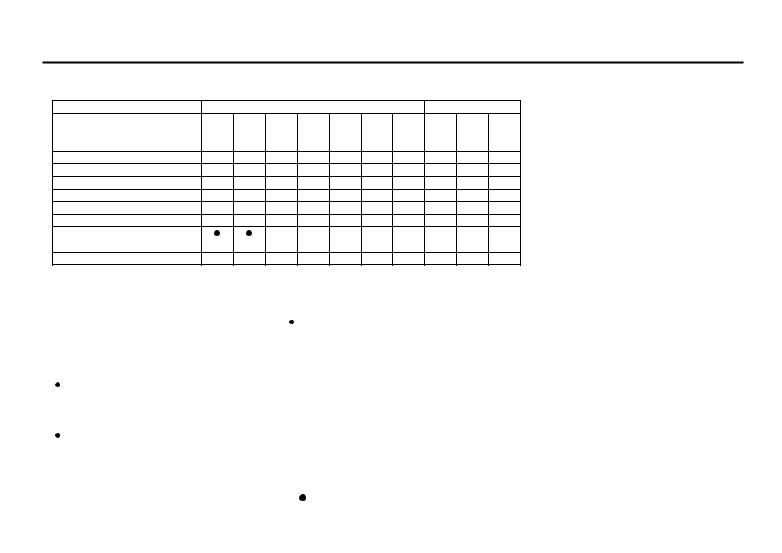
CONTROLS AND FEATURES
Model |
|
|
|
BF15D |
|
|
|
|
BFP15D |
|
Type |
SHA |
LHA |
SHSA LHSA SHTA LHTA LRTA XHTA LRTA XRTA |
|||||||
Shaft Length |
S |
L |
S |
L |
L |
L |
L |
X |
L |
X |
Tiller Handle |
H |
H |
H |
H |
H |
H |
|
H |
|
|
Remote Control |
|
|
|
|
|
|
|
|
|
|
Electric Starter |
|
|
S |
S |
S |
S |
S |
S |
S |
S |
Power Tilt |
|
|
|
|
T |
T |
T |
T |
T |
T |
Power Thrust Propeller |
|
|
|
|
|
|
|
P |
P |
P |
Battery Charging DC |
|
|
|
|
|
|
|
|
|
|
Receptacle |
|
|
|
|
|
|
|
|
|
|
Tachometer |
|
|
|
|
|
|
|
|
|
|
Refer to this chart for an explanation of the Type Codes used in this manual to identify control and feature applications.
BF15D/BFP15D are provided with the |
Tilt system |
|
|
|
(Example) |
|
|
|
|
||||||
following types according to the shaft |
T : Power Tilt (with hydraulic assist |
|
L |
|
H |
S |
A |
||||||||
length, control system, tilt system, and start |
function) |
|
|
|
|
|
|
|
|
|
|
|
|
|
|
system. |
|
|
|
|
|
|
|
|
|
|
|
|
|
|
Destination |
|
|
|
|
|
|
|
|
|
|
|
|
|
|
||
Shaft Length |
|
|
|
|
|
|
|
|
|
|
|
|
|
|
A=United States |
|
|
|
|
|
|
|
|
|
|
|
|
|
|
S=Electric Starter |
|
|
|
|
|
|
|
|
|
|
|
|
|
|
|
||
S: Short Shaft |
|
|
|
|
|
|
|
|
|
|
|
|
|
|
T=Power Tilt |
L: Long Shaft |
|
|
|
|
|
|
|
|
|
|
|
|
|
|
None=Manual Tilt |
X: Extra Long Shaft |
|
|
|
|
|
|
|
|
|
|
|
|
|
|
R=Remote Control |
|
|
|
|
|
|
|
|
|
|
|
|
|
|
||
Control System |
|
|
|
|
|
|
|
|
|
|
|
|
|
|
H=Tiller Handle |
H: Tiller Handle Control |
|
|
|
|
|
|
|
|
|
|
|
|
|
|
S=Short Shaft |
|
|
|
|
|
|
|
|
|
|
|
|
|
|
||
R: Remote Control |
|
|
|
|
|
|
|
|
|
|
|
|
|
|
L=Long Shaft |
|
: Optional Equipment |
|
|
|
|
|
|
|
|
|
|
|
|
|
X=Extra Long Shaft |
|
|
|
|
|
|
|
|
|
|
|
|
|
|
|
|
|
: Standard Equipment |
|
|
|
|
|
|
|
|
|
|
|
|
|
|
|
|
|
|
|
|
|
|
|
|
|
|
|
|
|
|
12
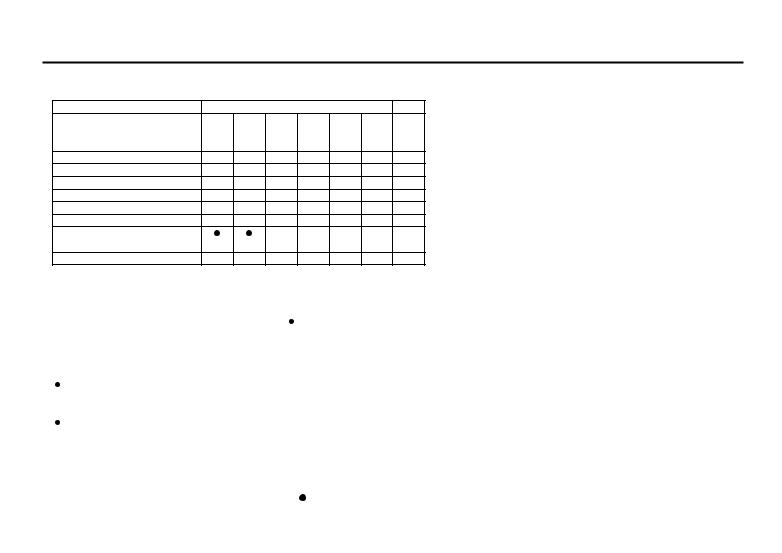
CONTROLS AND FEATURES
Model |
|
|
BF20D |
|
|
BFP20D |
|
Type |
SHA |
LHA SHTA LHTA SRTA LRTA LRTA |
|||||
Shaft Length |
S |
L |
S |
L |
S |
L |
L |
Tiller Handle |
H |
H |
H |
H |
|
|
|
Remote Control |
|
|
|
|
|
|
|
Electric Starter |
|
|
S |
S |
S |
S |
S |
Power Tilt |
|
|
T |
T |
T |
T |
T |
Power Thrust Propeller |
|
|
|
|
|
|
P |
Battery Charging DC |
|
|
|
|
|
|
|
Receptacle |
|
|
|
|
|
|
|
Tachometer |
|
|
|
|
|
|
|
Refer to this chart for an explanation of the Type Codes used in this manual to identify control and feature applications.
BF20D/BFP20D are provided with the |
Tilt system |
|
|
|
(Example) |
|
|
|
|
||||||
following types according to the shaft |
T : Power Tilt (with hydraulic assist |
|
L |
|
H |
S |
A |
||||||||
length, control system, tilt system, and start |
function) |
|
|
|
|
|
|
|
|
|
|
|
|
|
|
system. |
|
|
|
|
|
|
|
|
|
|
|
|
|
|
Destination |
|
|
|
|
|
|
|
|
|
|
|
|
|
|
||
Shaft Length |
|
|
|
|
|
|
|
|
|
|
|
|
|
|
A=United States |
|
|
|
|
|
|
|
|
|
|
|
|
|
|
S=Electric Starter |
|
|
|
|
|
|
|
|
|
|
|
|
|
|
|
||
S: Short Shaft |
|
|
|
|
|
|
|
|
|
|
|
|
|
|
T=Power Tilt |
L: Long Shaft |
|
|
|
|
|
|
|
|
|
|
|
|
|
|
None=Manual Tilt |
Control System |
|
|
|
|
|
|
|
|
|
|
|
|
|
|
R=Remote Control |
|
|
|
|
|
|
|
|
|
|
|
|
|
|
||
H: Tiller Handle Control |
|
|
|
|
|
|
|
|
|
|
|
|
|
|
H=Tiller Handle |
R: Remote Control |
|
|
|
|
|
|
|
|
|
|
|
|
|
|
S=Short Shaft |
|
|
|
|
|
|
|
|
|
|
|
|
|
|
||
|
|
|
|
|
|
|
|
|
|
|
|
|
|
|
L=Long Shaft |
|
: Optional Equipment |
|
|
|
|
|
|
|
|
|
|
|
|
|
|
|
: Standard Equipment |
|
|
|
|
|
|
|
|
|
|
|
|
|
|
|
|
|
|
|
|
|
|
|
|
|
|
|
|
|
|
13
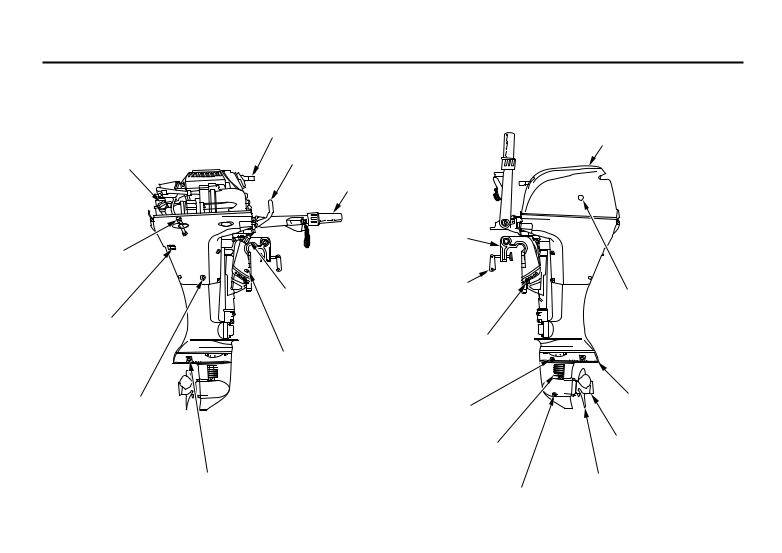
CONTROLS AND FEATURES
COMPONENT AND CONTROL LOCATIONS H Type (tiller handle)
OIL FILLER CAP
OIL LEVEL
DIPSTICK
COOLING SYSTEM INDICATOR
ENGINE OIL
DRAIN SCREW
STARTER GRIP |
|
ENGINE COVER |
|
|
|
GEARSHIFT LEVER |
|
|
TILLER HANDLE |
|
|
STERN BRACKET |
|
|
|
CLAMP SCREW |
|
TILT LEVER |
|
FLUSH PORT HOLE |
(manual tilt type) |
|
(inside engine cover) |
|
TRANSOM ANGLE |
|
MANUAL |
ADJUSTING ROD |
|
RELIEF VALUE |
|
|
(T type) |
|
ANTIVENTILATION |
|
GEAR OIL |
|
|
PLATE |
|
|
LEVEL SCREW |
|
|
COOLING WATER |
EXHAUST PORT |
|
|
|
|
INTAKE PORT |
|
ANODES |
(each side) |
PROPELLER |
|
||
(each side) |
GEAR OIL DRAIN/FILL SCREW |
|
14
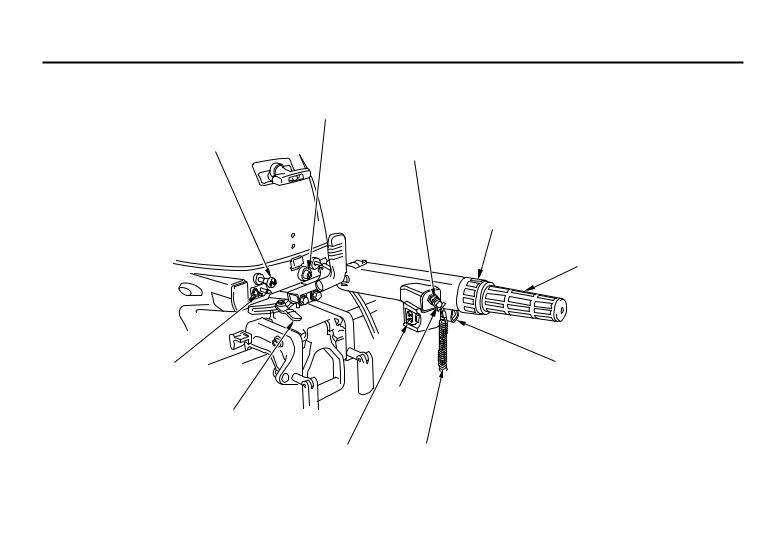
CONTROLS AND FEATURES
OIL PRESSURE
INDICATOR
CHOKE KNOB
(manual choke type)
SWITCH CLIP
THROTTLE
FRICTION
ADJUSTER
THROTTLE
GRIP
FUEL HOSE |
ELECTRIC STARTER BUTTON |
CONNECTOR |
(electric start type) |
|
ENGINE |
STEERING |
STOP |
SWITCH |
|
FRICTION |
|
LEVER |
LANYARD |
POWER TILT |
|
SWITCH |
|
(T type) |
|
15
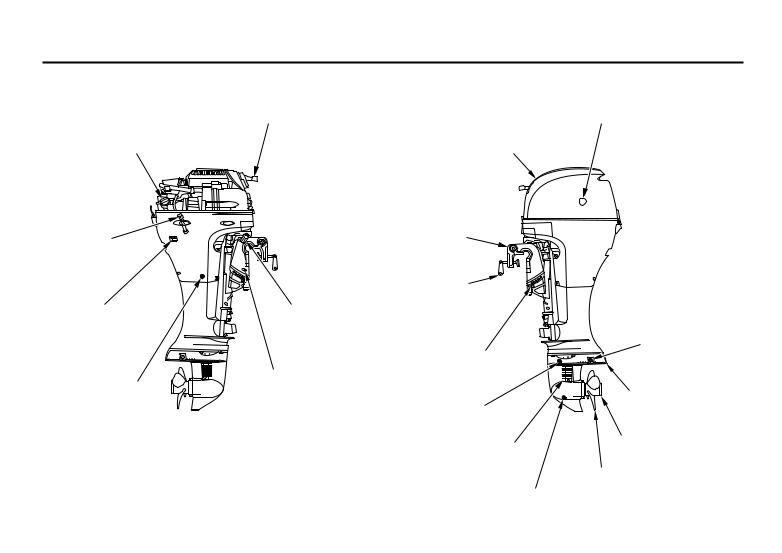
CONTROLS AND FEATURES
R Type (remote control)
STARTER GRIP |
FLUSH PORT HOLE (inside engine cover) |
OIL FILLER CAP |
ENGINE COVER |
OIL LEVEL |
|
STERN BRACKET |
DIPSTICK |
|
|
|
|
CLAMP SCREW |
|
|
(applicable types) |
COOLING SYSTEM |
TILT LEVER |
|
INDICATOR |
(manual tilt type) |
|
|
|
TRANSOM ANGLE |
|
MANUAL |
ADJUSTING ROD |
ENGINE OIL |
|
|
RELIEF VALVE |
|
|
DRAIN SCREW |
(T type) |
GEAR OIL |
|
|
LEVEL SCREW |
|
|
COOLING WATER |
|
|
INTAKE PORT |
|
|
(each side) |
ANODES (each side)
ANTIVENTILATION
PLATE
EXHAUST PORT
PROPELLER
GEAR OIL DRAIN/FILL SCREW
16
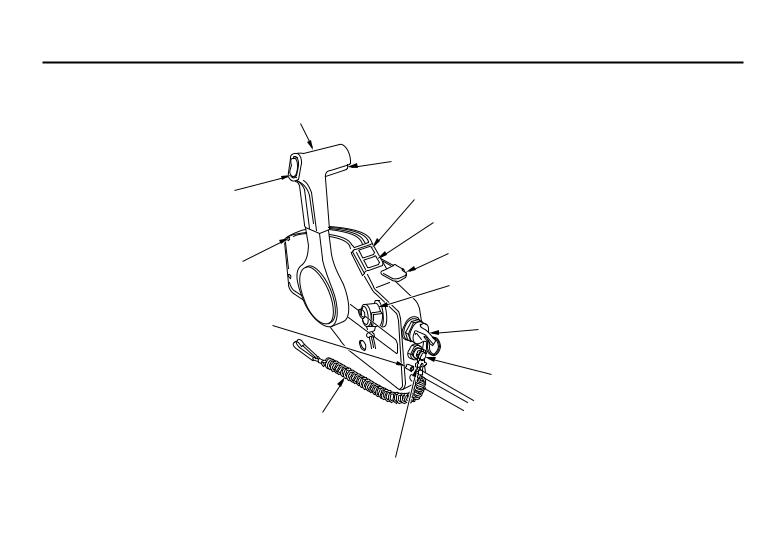
CONTROLS AND FEATURES
Remote Control box (optional equipment) (side-mount type)
GEARSHIFT/THROTTLE CONTROL LEVER
|
NEUTRAL RELEASE LEVER |
POWER TILT SWITCH |
OIL PRESSURE INDICATOR |
(T type) |
|
|
OVERHEAT INDICATOR |
SPARE SWITCH CLIP |
FAST IDLE LEVER |
|
|
|
BUZZER (inside box) |
REMOTE CONTROL |
|
FRICTION ADJUSTER |
IGNITION SWITCH |
|
EMERGENCY STOP SWITCH |
|
LANYARD |
|
SWITCH CLIP |
17

CONTROLS AND FEATURES
Tachometer |
Portable Fuel Tank |
|
[optional equipment (R type)] |
|
|
|
FUEL GAUGE |
VENT KNOB |
FUEL TANK
|
FUEL FILLER CAP |
|
FUEL HOSE |
TACHOMETER |
PRIMING BULB |
|
|
|
FUEL HOSE CONNECTOR |
|
(FEMALE) |
18
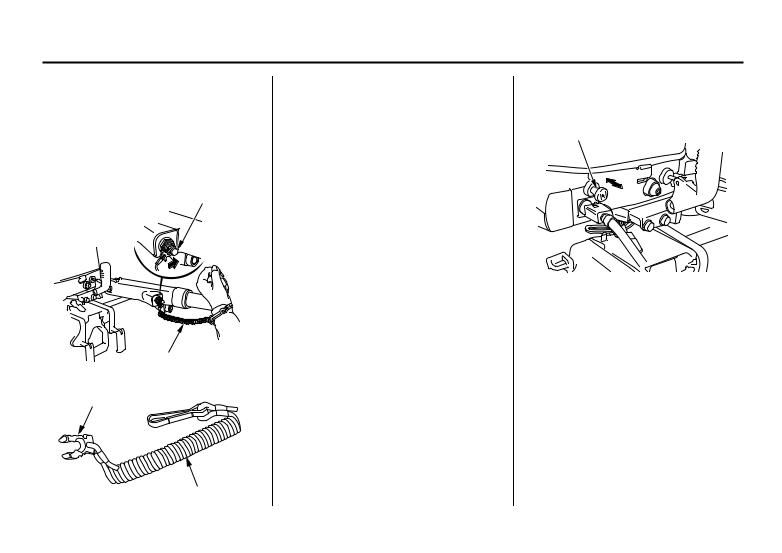
CONTROLS AND FEATURES
CONTROLS |
The engine stop switch has controls |
|
H Type (tiller handle) |
for normal engine stopping and |
|
emergency engine stopping. |
||
Engine Stop Switch and Switch |
The switch clip must be inserted in |
|
Clip |
the engine stop switch in order for |
|
ENGINE STOP |
the engine to start and run. The |
|
lanyard should be attached to the |
||
SWITCH |
||
operator’s PFD (Personal Flotation |
||
|
||
|
Device) or worn around the wrist as |
|
|
shown. |
|
|
When used as described, the engine |
|
|
stop switch and lanyard system stops |
|
|
the engine if the operator falls away |
|
|
from the controls. |
|
|
A spare switch clip is supplied in the |
|
LANYARD |
tool bag with the motor. |
|
SWITCH CLIP |
|
LANYARD
Choke Knob (manual choke type)
CHOKE KNOB
OFF
ON
The choke knob opens and closes the choke valve in the carburetor.
The ON position enriches the fuel mixture for starting a cold engine.
The OFF position provides the correct fuel mixture for operation after starting, and for restarting a warm engine.
19
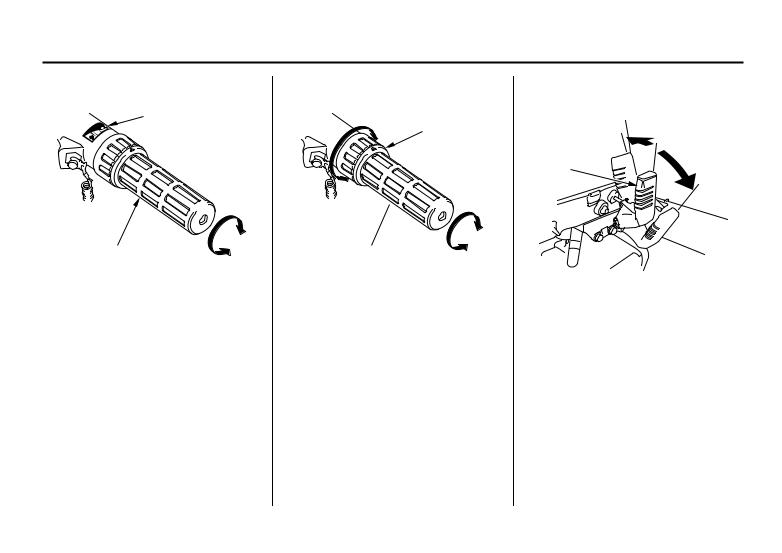
CONTROLS AND FEATURES
Throttle Grip
THROTTLE INDEX
MARK
THROTTLE GRIP
The throttle grip controls engine speed.
An index mark on the tiller arm shows throttle position and is helpful for setting the throttle correctly when starting (p. 47 ).
Throttle Friction Adjuster
FIX
THROTTLE
FRICTION
ADJUSTER
RELEASE 
THROTTLE GRIP
The throttle friction adjuster adjusts resistance to throttle grip rotation.
Turn the adjuster clockwise to increase friction for holding a throttle setting while cruising.
Turn the adjuster counterclockwise to decrease friction for easy throttle grip rotation.
Gearshif t Lever
R (reverse) |
N (neutral) |
GEARSHIFT |
F (forward) |
LEVER |
|
The gearshift lever is used to select F (forward), N (neutral), or R (reverse) gears.
The engine can be started with the gearshift lever in the N (neutral) position only.
If the gearshift lever is in the F (forward) or R (reverse) position, the recoil starter will not operate, and the electric starter button (applicable models) will not operate the starter motor.
20

CONTROLS AND FEATURES
Starter Grip
STARTER GRIP
Pulling the starter grip operates the recoil starter to crank the engine for starting.
The engine will not start unless the gearshift lever is in the N (neutral) position (p. 47 ), and the clip is in the engine stop switch.
Electric Starter Button (types equipped with electric starter)
SWITCH CLIP
ELECTRIC STARTER BUTTON
Press the starter button to operate the electric starter for starting the engine.
The electric starter button can be used to start the engine only when the gearshift lever is in the N (neutral) position (p. 47 ), and the clip is in the engine stop switch.
Steering Friction Lever
 FREE
FREE
LOCK
STEERING FRICTION LEVER
The steering friction lever adjusts steering resistance.
Less friction allows the outboard motor to turn more easily. More friction helps to hold steady course while cruising or to prevent the outboard motor from swinging while trailering the boat.
21
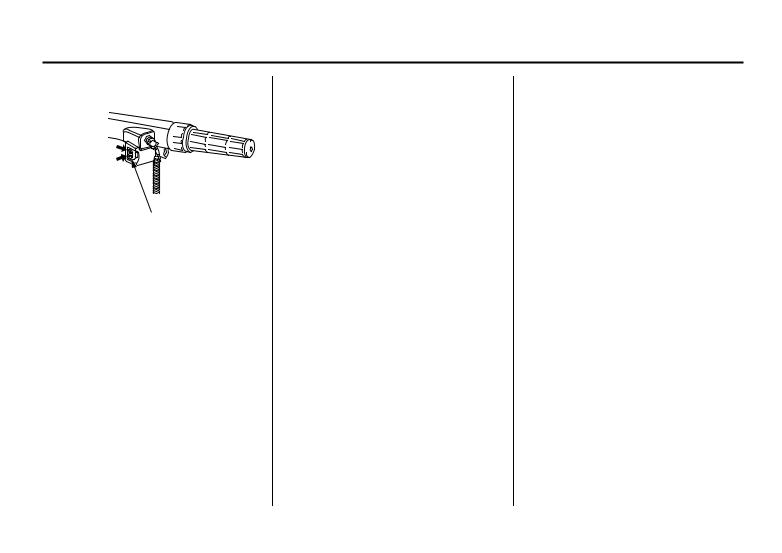
CONTROLS AND FEATURES
Power Tilt Switch (T type)
Press UP to tilt the motor up.
Press DN to tilt the motor down.
POWER TILT SWITCH
The rocker type power tilt switch has UP and DN (down) positions for changing the angle of the outboard motor.
Power tilt is a convenience for tilting the motor, shallow water operation, and trailering only. It is not designed to be used as a trim function to adjust the trim angle of the boat.
During shallow water operation, beaching, launching, or mooring, proceed at low speed with a small throttle opening and tilt the motor up as necessary (p. 62 ).
22
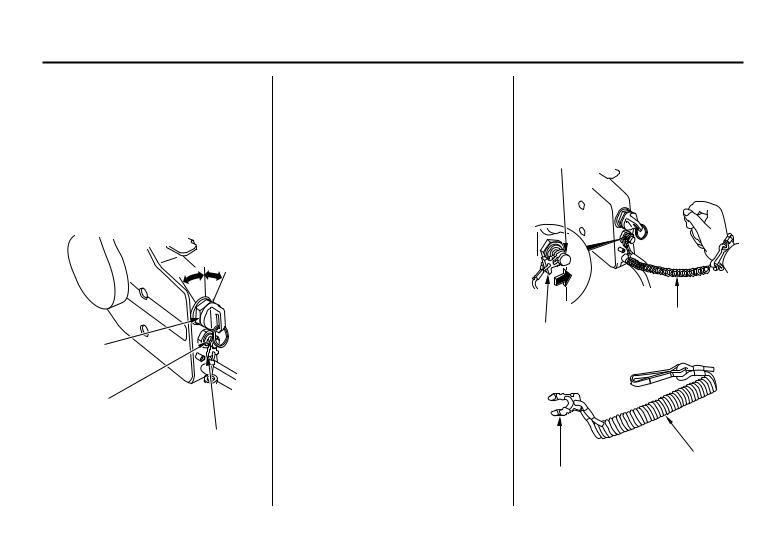
CONTROLS AND FEATURES
R Type (remote control)
For panel-mount or top-mount remote control information, refer to the instructions provided with the remote control equipment.
Ignition Switch (side-mount type)
OFF ON START
IGNITION
SWITCH
EMERGENCY STOP
SWITCH
SWITCH CLIP
The ignition switch controls the ignition system and the starter motor.
Turning the ignition switch key to the START position operates the starter motor. The key automatically returns to the ON position when released from the START position.
The ignition switch can be used to start the engine only when the gearshift/throttle control lever is in the N (neutral) position (p. 49 ), and the switch clip is in the emergency stop switch.
Turning the ignition switch to the OFF position stops the engine.
Emergency Stop Switch and Switch Clip (side-mount type)
EMERGENCY
STOP SWITCH
LANYARD
SWITCH CLIP
LANYARD
SWITCH CLIP
23
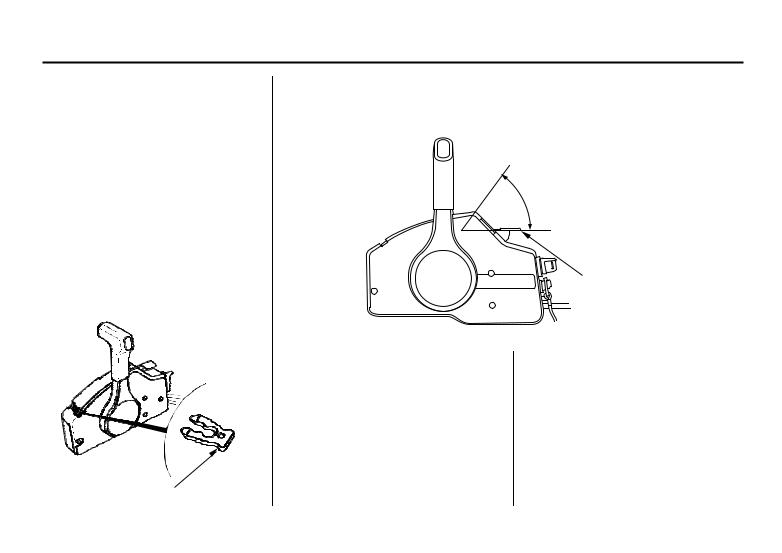
CONTROLS AND FEATURES
The switch clip must be inserted in the emergency stop switch in order for the engine to start and run. The lanyard must be attached to the operator’s PFD (Personal Flotation Device) or worn around the wrist as shown.
When used as described, the emergency stop switch and lanyard system stops the engine if the operator falls away from the controls.
A spare switch clip is stored in a slot in the control housing.
SPARE SWITCH CLIP
Fast Idle Lever
(side-mount type)
MAXIMUM FAST IDLE
LOWEST POSITION
FAST IDLE LEVER
The fast idle lever is used to set idle speed during warm-up.
The lever will not move unless the gearshift/throttle control lever is in the N (neutral) position. The fast idle lever must be in its lowest position for you to move the gearshift/throttle control lever out of neutral.
Leave the fast idle lever in the lowest position to provide a rich fuel mixture for starting a cold engine.
Lift the fast idle lever to accelerate the warm up of a cold engine after starting and to start a warm engine.
24
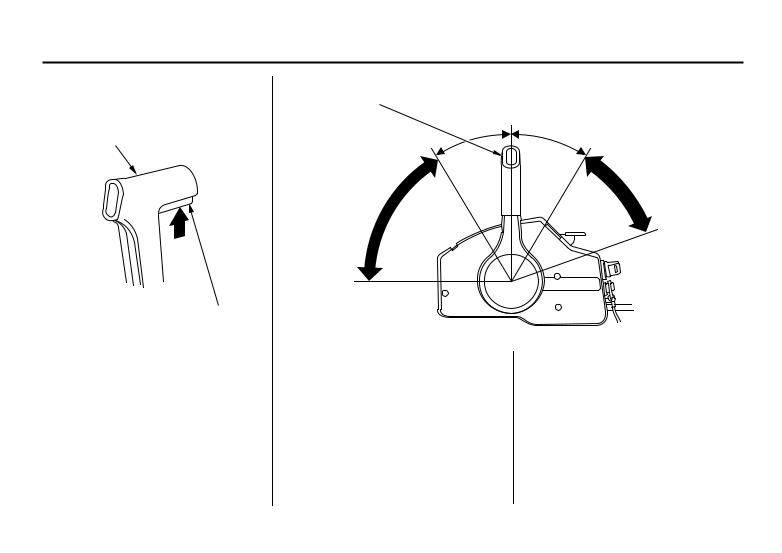
CONTROLS AND FEATURES
Gearshif t/Throttle Control Lever (side-mount type)
GEARSHIFT/THROTTLE
CONTROL LEVER
NEUTRAL RELEASE LEVER
The control lever automatically locks itself in the N (neutral) position. To move the lever out of the N (neutral) position, you must squeeze the neutral release lever on the underside of the lever handle.
GEARSHIFT/THROTTLE
CONTROL LEVER
|
N (neutral) |
30° |
30° |
F (forward) |
R (reverse) |
ENGINE SPEED
ENGINE
SPEED
HIGH
HIGH
The gearshift/throttle control lever controls engine speed and selects F (forward), N (neutral), or R (reverse) gears.
Moving the control lever 30° from N (neutral) selects the gear, and further movement increases engine speed.
A friction adjuster near the base of the control lever adjusts the operating resistance of the control lever (p. 57 ).
Less friction allows easier control lever movement. More friction helps to hold a steady throttle setting while cruising.
25
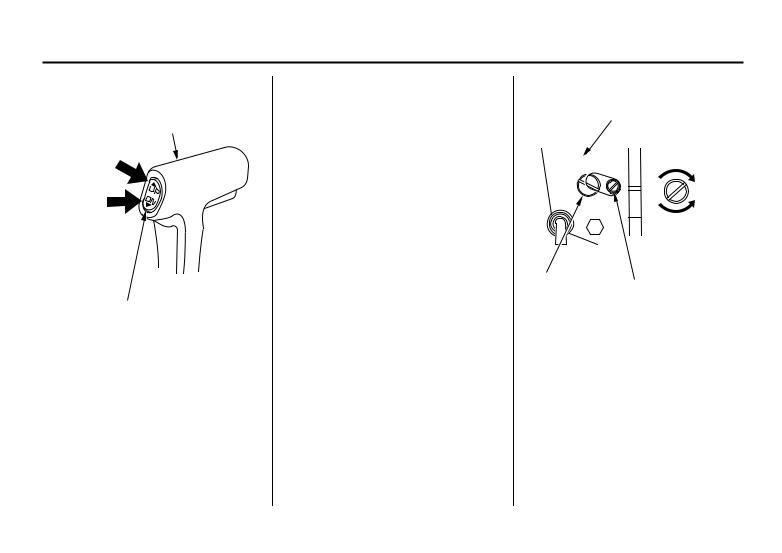
CONTROLS AND FEATURES
Power Tilt Switch (T type) (side-mount type)
CONTROL LEVER
Press UP to tilt the motor up.
Press DN to tilt the motor down.
POWER TILT SWITCH
The rocker type power tilt switch is located on the control lever and has UP and DN (down) positions for changing the angle of the outboard motor.
Power tilt is a convenience for tilting the motor, shallow water operation, and trailering only. It is not designed to be used as a trim function to adjust the trim angle of the boat.
During shallow water operation, beaching, launching, or mooring, proceed at low speed with a small throttle opening and tilt the motor up as necessary (p. 62 ).
Manual Relief Valve (T type)
RIGHT STERN BRACKET
MANUAL (Valve closed to fix)
POWER (Valve open to release)
MANUAL RELIEF VALVE
: Do not turn this screw. If this screw is turned hydraulic oil will bleed out of the power tilt system. Should this happen it will be necessary to consult your authorized Honda marine dealer and have the system refilled.
The outboard motor can be tilted manually after opening the manual relief valve. This allows the outboard motor to be tilted when no battery is connected.
26
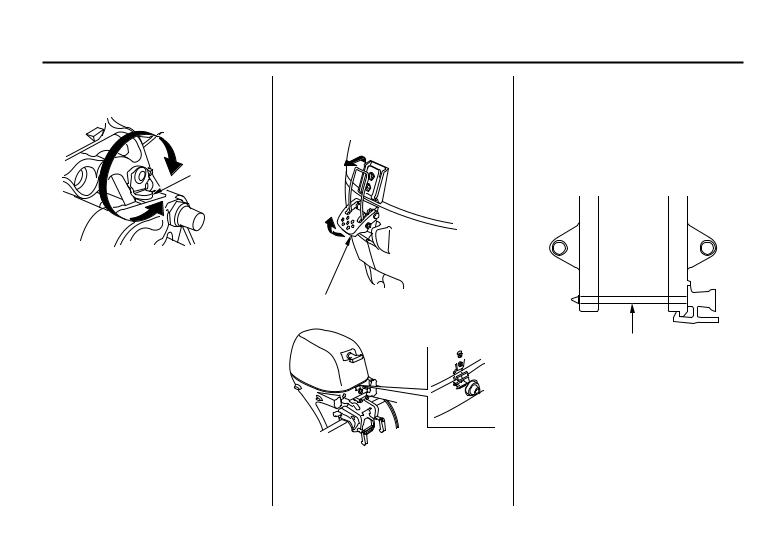
CONTROLS AND FEATURES
Tilt Lock Lever (T type)
FREE
TILT LOCK
LEVER
LOCK
The tilt lock lever is used to support the outboard motor in the fully-raised position.
When the boat is to be moored for a long time, tilt the outboard motor up as far as it will go. Then move the tilt lock lever to the LOCK position, and gently lower the outboard motor until the lever contacts the stern bracket.
Common Controls |
Transom Angle Adjusting Rod |
Engine Cover Latch |
The transom angle adjusting rod |
|
limits the tilt angle of the outboard |
|
motor when fully lowered. |
|
(manual tilt SH type/LH type) |
ENGINE COVER LATCH
ADJUSTING ROD
The engine cover latch fastens the engine cover to the outboard motor.
27
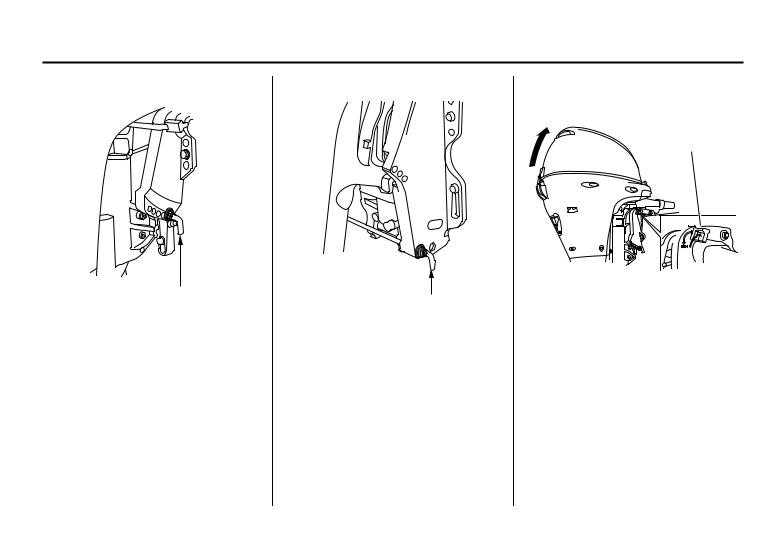
CONTROLS AND FEATURES
(manual tilt/XH type and R type) |
(T type) |
ADJUSTING ROD |
ADJUSTING ROD |
|
(storage location) |
|
There are four transom angle |
|
adjustment positions. Three are |
|
controlled by the adjusting rod and |
|
the fourth is controlled by the stern |
|
bracket. In order to use the fourth |
|
position, remove the adjusting rod |
|
and store it in the storage location, |
|
then lower the motor down to the |
|
stern bracket stop position. |
Tilt Lever (manual tilt type)
TILT LEVER
 TILT
TILT
RUN (LOCK)
(LOCK)
The tilt lever enables the outboard motor to be raised for shallow water operation, beaching, launching, or mooring.
To tilt, move the lever to the TILT position, then raise the outboard motor until the tilt mechanism engages at 22°, 37°, 63° or 64° (p. 61 ).
28
